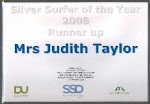From The Aga Recipe Book for 2 oven Aga Cookers [no publication date but purchased in 1960]
SCONES
Recipe
8 ozs. plain flour
1/2-1 oz. butter
1/4 pt. milk (sour if possible)
1 teaspoon cream of tartar
(1/2 teaspoon if sour milk used)
1/2 teaspoon bicarbonate of soda
1/2 teaspoon salt
.
METHOD
Sift together the dry ingredients. Rub in the butter and mix quickly with the liquid. Turn on to a floured board. Knead lightly and roll to 1/2 inch thickness. Mark into eight, or cut with a shrp round cutter. Bake for 7-10 minutes on the top shelf of the roasting oven, turning once during baking.
.
.
From Mrs Beeton’s Cookery and Household Management, 1960
IMPORTANT POINTS TO REMEMBER WHEN MAKING SCONES
1. If the basic proportions are correct they can be varied in many different ways
- see suggestions.
2. It is most essential to be accurate with proportions, e.g. too much soda will ruin
the scones.
3. Whereas yeast mixtures are kept warm, scones etc. made with other raising
agents should be kept as cool as possible. The cold air expands with the heat
and so helps to make the scones lighter.
4. The best utensil for mixing scones is a round-bladed knife; it gets well down to
to the bottom of bowl and can be used for mixing without pressing on the
mixture.
5. The most important rule is to add all the liquid at once and mix lightly to a spongy
dough.
6. The scones should be handled as little and as lightly as possible.
7. Scones should be cooked quickly - 10 minutes in a hot oven for small scones
and 15 minutes for a round of 4 or 6.
8. Cool oven scones on a cooling tray to keep the outside crisp. Girdle scones are
best cooled in a tea towel to keep the skin soft.
NOTE: From Experiment it has been found that better results are obtained if the scones are allowed to stand (after cutting out) for 10 minutes before cooking. This applies to scones raised with bicarbonate of soda and cream of tartar.
IMPORTANT POINTS TO REMEMBER WHEN MAKING SCONES
1. If the basic proportions are correct they can be varied in many different ways
- see suggestions.
2. It is most essential to be accurate with proportions, e.g. too much soda will ruin
the scones.
3. Whereas yeast mixtures are kept warm, scones etc. made with other raising
agents should be kept as cool as possible. The cold air expands with the heat
and so helps to make the scones lighter.
4. The best utensil for mixing scones is a round-bladed knife; it gets well down to
to the bottom of bowl and can be used for mixing without pressing on the
mixture.
5. The most important rule is to add all the liquid at once and mix lightly to a spongy
dough.
6. The scones should be handled as little and as lightly as possible.
7. Scones should be cooked quickly - 10 minutes in a hot oven for small scones
and 15 minutes for a round of 4 or 6.
8. Cool oven scones on a cooling tray to keep the outside crisp. Girdle scones are
best cooled in a tea towel to keep the skin soft.
NOTE: From Experiment it has been found that better results are obtained if the scones are allowed to stand (after cutting out) for 10 minutes before cooking. This applies to scones raised with bicarbonate of soda and cream of tartar.
.



No comments:
Post a Comment